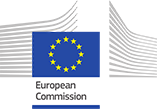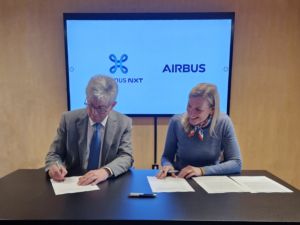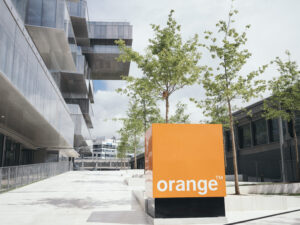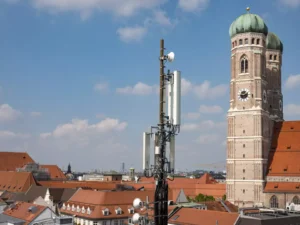One of the main differences between 5G and the previous generations of cellular networks (3G and LTE/4G) lies in the strong focus on machine-type communication enabling the Internet of Things (IoT). 5G will use spectrum that covers the existing LTE frequency range (600 MHz to 6 GHz) combined with the new millimetre wave bands (24-86 GHz) to encompass key features such as low latency, high throughput, high mobility and high connection density. The capabilities of 5G thus extennd well beyond mobile broadband with ever-increasing data rates.

5G Action Plan
In September 2016, the European Commission launched its “5G Action Plan” to boost investments and rollout efforts for 5G infrastructure and services by 2020, thanks to the creation of a Digital Single Market. This plan sets a clear roadmap for public and private 5G investments in the EU. The Commission has proposed the following measures to achieve the plan’s objectives:
- Harmonise national priorities and timetables for coordinated deployment across all EU member countries, aiming for early deployments by 2018
- Reserve spectrum bands for 5G immediately, without waiting for WRC’19
- Promote rapid and early deployment in large urban centres and along major transport routes
- Promote trials by multiple pan-European stakeholders to galvanise the transition from technological innovation to the mass market
- Facilitate the implementation of private investments in 5G innovation
- Federate the core players, to work together on promoting global standards
The European Commission announced at the end of February 2021 it would announce a new 5G Action Plan soon (early March 2021). Details on the Action Plan v2 have not been disclosed but it may set a few goals as the V1 5G Action Plan targets “have been useful” according to the European Commission speaking at the European 5G conference end of February 2021.
The upcoming goals could focus again on spectrum assignments, especially on high bands, on the deployment of small cells, and on vertical industries.
3GPP’s 5G New Radio
In December 2017, the first set of specifications defined 5G New Radio (NR) in Non-Standalone operation (NSA), enabling 5G NR deployments using existing 4G systems.
The specifications of 5G NR in Standalone operation were approved in June 2018, and provide a complete set of specifications for the 5G Core Network that goes beyond Non-Standalone. The ‘full’ 5G System includes:
- eMBB (enhanced Mobile Broadband)
- URLLC (Ultra-Reliable Low Latency Communications)
- mMTC (massive Machine Type Communications)
3GPP has split the 5G standard into two distinct releases: Release 15 corresponds to 5G NR phase 1 while release 16 corresponds to 5G NR phase 2.
Release 15 covers ‘standalone’ 5G, with a new radio system and a new core network. It includes enhancements to LTE and to the Evolved Packet Core (EPC). It focuses on eMBB services.
Main enhancements in release 16 include multiple-input, multiple-output (MIMO) and beamforming enhancements, dynamic spectrum sharing (DSS), dual connectivity (DC) and carrier aggregation (CA), user equipment (UE) improved power efficiency and extended uplink coverage. Release 16 opens up 5G to industry verticals with 5G V2X, NR in unlicensed bands, in-band eMTC and NB-IoT and positioning. Release 17 will accelerate the expansion of 5G and introduces boundless extended reality, higher precision in positioning, new spectrum and obviously continued eMBB enhancements including coverage, mobility….
ITU-T IMT2020
he ITU’s Telecommunication Standardisation Sector (ITU-T) Study Groups develop international standards known as ITU-T Recommendations, which act as defining elements in the global infrastructure of information and communication technologies (ICT).
The latest ITU standards include:
- ITU Y.3101 “Requirements of the IMT-2020 network” describes the features of 5G networks necessary to ensure efficient 5G deployment and high network flexibility.
- ITU Y.3150 “High-level technical characteristics of network softwarisation for IMT-2020” describes the value of slicing in both horizontal and vertical, application-specific environments.
- ITU Y.3130 “Requirements of IMT-2020 fixed-mobile convergence” calls for unified user identity, unified charging, service continuity, guaranteed support for high quality of service, control plane convergence and smart management of user data.
The 5G wireline standards that the study group 13 (SG13) developed and approved in 2017 include:
- ITU Y.3071 “Data Aware Networking (Information Centric Networking) – Requirements and Capabilities” will support ultra-low latency 5G communications by enabling proactive in-network data caching and limiting redundant traffic in core networks.
- ITU Y.3100 “Terms and definitions for IMT-2020 network” provides a foundational set of terminology to be applied universally across 5G-related standardisation work.
- ITU Y.3111 “IMT-2020 network management and orchestration framework” establishes a framework and related principles for the design of 5G networks.
- ITU Y.3310 “IMT-2020 network management and orchestration requirements” describes the capabilities required to support emerging 5G services and applications.
- Supplement 44 to the ITU Y.3100 series “Standardisation and open source activities related to network softwarisation of IMT-2020” summarises open-source and standardisation initiatives relevant to ITU’s development of standards for network softwarisation.
5G-PPP
The European Commission has expressed its objectives as part of the H2020 initiative for the development and modernisation of European cities, which includes the 5G Public-Private Partnership (5G-PPP), a cooperative initiative between private and public institutions for test beds and experimental applications for 5G in Europe.
The development of 5G in Europe is making progress thanks to a joint strategy between industry players, academic research centres and the European Commission. The strategy relies on the development of specific projects addressing 5G vertical pilots and 5G platforms, such as 5G Pan-EU events and the 5G Trials Cities programme. The 5G Pan-EU roadmap leverages cooperation between ecosystem partners in different European countries, and so enabling interoperability. The 5G Pan-European Trials Roadmap covers a broader scope than the 5G Action Plan (5GAP) and the 5G Infrastructure PPP Phase 3.
The Roadmap version 3.0, released by 5G-PPP in May 2018, is coordinated by the 5G Infrastructure Association (5G-IA), expanding on the work initiated by private-sector parties and the European Commission (EC) as part of the 5G Manifesto and the 5G Action Plan (5GAP).
The Roadmap’s main objectives are to:
- Support Europe’s global leadership in 5G technology, network deployment and creating profitable businesses.
- Validate 5G’s benefits to vertical sectors, including the public sector, businesses and consumers.
- Generate a clear path to successful and timely 5G deployment in Europe.
The projects of the third phase of the 5G PPP show the way for these new use cases and deliver on Europe’s 5G trial strategy. The whole 5G PPP trial project portfolio is now worth more than EUR 300 million of EU funding, and is expected to leverage more than EUR 1 billion of private investment in 5G vertical trials, reinforcing Europe’s leading position in this field.
Another wave of projects was launched in 2020 in the last Work Programme of Horizon 2020. A second wave of 5G Corridor projects has been selected. Eight projects have been retained by the European Commission in response to the 5G PPP ICT-42-2020 call: “5G PPP 5G Core Technologies innovation”. They started in the second half 2020 and are already developing exciting advances in 5G. 5G PPP ICT-42-2020 call.
Nine projects (5GASP, 5G-EPICENTRE, 5G-ERA, 5G-IANA, 5G-INDUCE, 5GMEDIA HUB, evolved 5G, Smart5Grid, and Vital5G have been retained from the 29 proposals received by the EC in response to the 5G PPP ICT-41-2020 call: 5G PPP 5G innovations for verticals with third party services
Nine other projects (6GBRAINS, AI@EDGE, DAEMON, DEDICAT 6G, Hexa-X, MARSAL, REINDEER, RISE-6G and TeraFlow) have been retained from the 81 proposals received by the EC in response to the 5G PPP ICT-52-2020 call: 5G PPP Smart Connectivity beyond 5G.
Smart Networks and Services
“As the Horizon 2020 framework programme comes to an end and the new Horizon Europe framework programme launches, the 5G IA, as the industrial partner of the 5G PPP, is preparing for the evolution of the 5G activities into the Smart Networks and Services contex within the Horizon Europe framework programme”. The new “networks and services” package will lay the foundation of 6G in Europe. It has been earmarked for 900 million EUR of public funding (for 1.8 billion EUR of PPP funding in total) over the 2021-2027 budget period.










